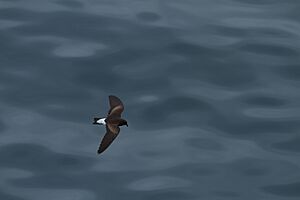Wedge-rumped storm petrel facts for kids
Quick facts for kids Wedge-rumped storm petrel |
|
|---|---|
 |
|
| Conservation status | |
| Scientific classification | |
| Genus: |
Hydrobates
|
| Species: |
tethys
|
 |
|
| Synonyms | |
|
Oceanodroma tethys |
|
The wedge-rumped storm petrel (its scientific name is Hydrobates tethys) is a small, ocean-loving bird. It's part of a group called storm petrels. These birds spend most of their lives flying over the sea. You can find the wedge-rumped storm petrel breeding in the Galápagos Islands and along the coast of Peru.
Contents
Meet the Wedge-rumped Storm Petrel
Storm petrels are some of the smallest seabirds in the world. They are known for their unique way of flying. They often "walk" on the water's surface, dipping their feet to pick up tiny food items. This makes them look like they are dancing on the waves! The wedge-rumped storm petrel was once known by a different scientific name, Oceanodroma tethys. Scientists later decided it belonged in the Hydrobates group.
Where Do They Live?
The wedge-rumped storm petrel loves warm waters. Its main breeding grounds are the famous Galápagos Islands. These islands are located in the Pacific Ocean, off the coast of Ecuador. They also nest along the coast of Peru. These birds spend most of their time far out at sea. They only come to land to lay their eggs and raise their chicks.
What Do They Eat?
These tiny birds are expert hunters of small sea creatures. They mostly eat tiny fish and squid. They also enjoy small crustaceans, which are like tiny ocean bugs. They catch their food by flying low over the water. Sometimes they even dip their feet to grab things from the surface.
Life Cycle and Reproduction
Wedge-rumped storm petrels usually nest in cracks in rocks or in burrows. They often choose places on remote islands. This helps keep their eggs and chicks safe from predators. The female bird lays just one egg. Both parents take turns sitting on the egg to keep it warm. They also share the job of feeding the chick once it hatches. The chick stays in the nest until it is old enough to fly and find its own food.
How Are They Doing?
The wedge-rumped storm petrel is currently listed as a species of "Least Concern" by conservation groups. This means their populations are stable right now. However, like all seabirds, they can be affected by changes in the ocean. Things like pollution or changes in fish populations can impact them. Protecting their ocean homes and nesting sites is important for their future.


